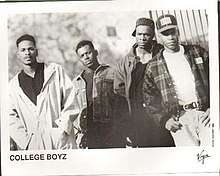College Boyz
The College Boyz was an American hip hop group and voice actors composed of R.O.M., Squeak, B. Selector and DJ Cue.[1]
College Boyz | |
|---|---|
 College Boyz | |
| Background information | |
| Also known as | RMG |
| Origin | Los Angeles, California, United States |
| Genres | Hip hop |
| Years active | 1991–1994 |
| Labels | Virgin/EMI Records |
| Members | R.O.M. Squeak B. Selector DJ Cue |
The group was signed to Virgin Records. Originally calling itself RMG, the group changed its name to College Boyz upon moving to Los Angeles.
They released their debut, Radio Fusion Radio, on April 7, 1992 through Virgin Records.[1] The album was not a huge success, but it managed to make it to three different charts, peaking at #118 on the Billboard 200, #25 on the Top R&B/Hip-Hop Albums and #2 on the Top Heatseekers. Radio Fusion Radio also featured the hit single "Victim of the Ghetto", which peaked at #68 on the Billboard Hot 100 and #1 on the Hot Rap Singles.
On October 4, 1994 the group released their second and final album Nuttin' Less Nuttin' Mo'.[1] It made it to #80 on the Top R&B/Hip-Hop Albums, and producing a single "Rollin" that reached #49 on the Hot Rap Singles. The College Boyz disbanded in 1994 with Romany "R.O.M." Malco eventually becoming a successful actor.
Discography
| Year | Album | Chart Positions | |||
|---|---|---|---|---|---|
| US | US Hip-Hop | Heatseekers | |||
| 1992 | Radio Fusion Radio | 118 | 25 | 2 | |
| 1994 | Nuttin' Less Nuttin' Mo' | - | 80 | - | |
| "—" denotes the album failed to chart or not released | |||||
References
- Colin Larkin, ed. (1998). The Virgin Encyclopedia of Dance Music (First ed.). Virgin Books. p. 60. ISBN 0-7535-0252-6.